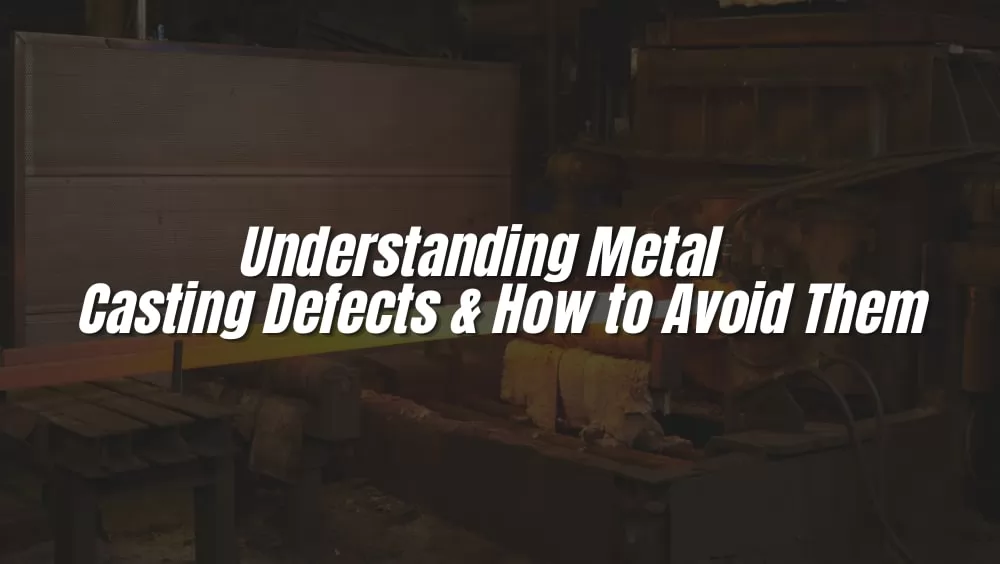
Metal casting is a fundamental manufacturing process used to create a wide variety of parts and products. From simple tools to complex machine components, casting offers flexibility and precision that few other methods can match. Understanding the basics of casting types and processes helps to appreciate its importance in many industries.
This guide will introduce you to the main casting methods and how each is used in different applications. Whether you’re new to the topic or looking to refresh your knowledge, you’ll find useful insights here.
Casting isn’t just about pouring molten metal—it’s about shaping the future of manufacturing. Let’s explore how this timeless process continues to evolve and power modern production.
Table of Contents
- What Are Metal Casting Defects?
- Common Types of Metal Casting Defects
- Causes of Metal Casting Defects
- How to Prevent Metal Casting Defects
- Cost-Benefit Analysis of Defect Prevention
- Industry Trends and Innovations
- FAQ
- Conclusion
What Are Metal Casting Defects?
Metal casting defects are flaws that form when molten metal solidifies, leading to imperfections like surface blemishes or hidden voids. These defects can weaken the finished part and affect its reliability.
Defects matter because they reduce product strength, increase waste and costs, and can harm a company’s reputation. Identifying and addressing defects early helps improve quality control and minimize rework.
Common Types of Metal Casting Defects
Different casting methods — like sand casting, investment casting, and die casting — can each have specific defects, but many problems are common across processes. Understanding these helps foundries catch issues early and improve product quality.
| Defect | Description |
|---|---|
| Porosity | Holes caused by trapped gas or shrinkage, weakening the part. |
| Shrinkage Defects | Cavities from metal shrinking without enough feed metal. |
| Cold Shuts | Metal streams meet but don’t fuse, causing cracks or lines. |
| Misruns | Incomplete filling of the mold before metal solidifies. |
| Hot Tears | Cracks formed during solidification due to mold restraint. |
| Inclusions | Foreign materials trapped inside, reducing strength. |
Porosity
Small holes or voids inside the metal, caused by trapped gas or shrinkage during cooling. Too much porosity weakens the part, so proper venting and clean metal handling are key.
Shrinkage Defects
Molten metal shrinks as it cools. Without enough feed metal to compensate, cavities or internal voids can form. Good riser and gating design helps prevent this.
Cold Shuts
When two streams of metal meet but don’t fuse properly, leaving a visible line or crack. This usually happens if the pouring temperature is too low or the flow is too slow.
Misruns
Happens when the mold cavity isn’t completely filled before the metal solidifies, often due to low temperature or poor mold design. Ensuring proper flow helps avoid this.
Hot Tears
Cracks that form during solidification when the casting contracts but is held back by the mold. Good mold design can help metal shrink freely and reduce hot tears.
Inclusions
Foreign materials like slag or sand get trapped in the metal, lowering strength. Clean molds and proper filtering help keep inclusions out.
Regular inspection — whether visual, ultrasonic, or X-ray — is essential for catching these defects early and ensuring reliable castings.
Causes of Metal Casting Defects

Defects in metal casting rarely have a single cause — they usually result from a mix of design flaws, process issues, and human factors. Understanding these root causes is key to reducing scrap and improving quality.
| Cause | Description |
|---|---|
| Design Issues | Poor design of gating, risers, or wall thickness. |
| Mold & Core | Low-quality sand, cracks, or poor preparation. |
| Process | Wrong temperature or inconsistent metal quality. |
| Human Error | Improper handling or lack of discipline. |
Design Issues
Poor gating and riser design can cause incomplete filling, shrinkage cavities, or cold shuts. Parts with thin walls may warp, crack, or fail to solidify properly. Early design reviews and simulations help catch these problems before production.
Mold & Core Problems
Low-quality sand, improper mold preparation, or poorly made cores can lead to gas holes, sand inclusions, or surface defects. Cracked molds during pouring may cause leaks or internal voids, especially in complex shapes.
Process Parameters
Pouring metal at the wrong temperature can result in incomplete filling or gas porosity. Variations in metal composition or poor melt quality can also introduce inclusions and weaken the casting. Careful monitoring keeps these variables under control.
Human Error
Improper handling of molds and cores, poor housekeeping, or lack of training can introduce misalignments and contamination. Clear procedures and well-trained staff help prevent avoidable mistakes.
How to Prevent Metal Casting Defects

You can’t eliminate every defect, but you can dramatically reduce their frequency with a systematic approach:
1. Design Smart:
Use advanced casting simulation software to predict how molten metal will flow, fill, and solidify inside the mold. This allows you to find weak points and adjust your design before production begins. Always design with properly placed feeders and risers to ensure enough molten metal feeds the casting as it shrinks during cooling.
2. Improve Mold Quality:
Choose high-quality, consistent molding materials that can withstand thermal stress and maintain shape. Ensure your molds have good permeability and sufficient venting so trapped gases can escape easily, which helps prevent porosity, blowholes, and other gas-related defects.
3. Control the Process:
Keep melting and pouring temperatures stable and within the correct range to avoid issues like cold shuts and misruns. Use reliable de-gassing techniques to remove dissolved gases from the molten metal, reducing the risk of internal voids and improving overall casting integrity.
4. Train Your Team:
Regularly train your foundry workers so they stay updated on best practices, safety, and quality standards. Foster a culture where everyone follows standard procedures closely and reports potential problems early so they can be addressed before becoming larger issues.
5. Inspect & Iterate:
Use non-destructive testing (NDT) methods such as ultrasonic testing, radiography, or dye penetrant inspections to detect hidden flaws without damaging the casting. Keep detailed records of defects, analyze the data for patterns, and use this knowledge to continually refine your designs, materials, and processes for better results over time.
Cost-Benefit Analysis of Defect Prevention
Is investing in defect prevention worth it? Absolutely.
Let’s break it down:
Prevention Costs:
These include expenses for purchasing and maintaining simulation software, hiring and training skilled labor, sourcing higher-quality materials, and performing thorough inspections throughout the manufacturing process. While these investments may increase upfront costs, they help catch and correct issues early, preventing costly mistakes later.
Failure Costs:
These are the costs incurred when defects slip through. They include scrap material, expensive rework or remanufacturing, warranty claims, damage to your brand reputation due to customer dissatisfaction, and even potential legal liabilities from faulty products. These costs can escalate quickly and severely impact profitability.
Research and industry studies consistently show that every $1 spent on defect prevention can save between $10 and $100 in failure-related costs. This significant return on investment makes prevention a clear win-win, enhancing both profitability and product quality. By focusing on prevention, companies reduce waste, improve customer satisfaction, and strengthen their competitive position in the market.
Industry Trends and Innovations

The metal casting industry is evolving rapidly, with leading foundries using advanced technologies to reduce defects. Tools like AI-driven casting simulations and 3D printed sand molds enhance precision and predict problems before production begins.
Automation is also transforming quality control, with robotics and machine vision enabling faster, more accurate inspections. Additionally, sustainable practices like recycling scrap metal and improving energy efficiency are helping lower costs and reduce environmental impact, keeping the industry competitive.
FAQ

Q: What’s the most common defect in sand casting?
A: Porosity is one of the most common defects, caused by trapped gases or shrinkage during solidification.
Q: How do I detect internal casting defects?
A: Use non-destructive testing methods such as ultrasonic inspection, radiography (X-ray), or CT scanning to detect internal flaws without damaging the casting.
Q: Can all casting defects be avoided?
A: Not entirely—while it is impossible to eliminate every defect, proper design, process control, and thorough inspection can significantly reduce their frequency and impact.
Conclusion
Metal casting remains a vital part of manufacturing, delivering durable and high-quality parts for countless industries. Knowing its processes and applications helps businesses make better decisions and innovate effectively.
With ongoing advancements in technology and materials, casting continues to adapt and improve, meeting today’s demands for efficiency and sustainability.
For reliable and innovative casting solutions, BESSER is a trusted partner that brings expertise and quality to your projects, helping you stay ahead in a competitive market.
Related Recommendations:
Top 10 Investment Casting Manufacturers & Suppliers in China
Best 10 Metal Casting Manufacturers and Suppliers
Top 10 Lost Wax Casting Companies: Latest List
How to source precision castings from China?
Best 10 Metal Casting Companies in the World



